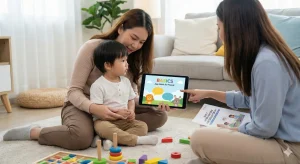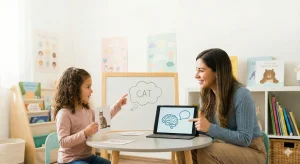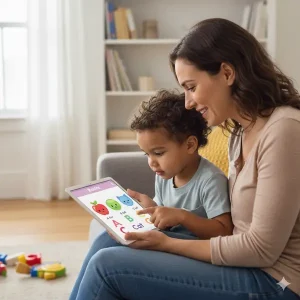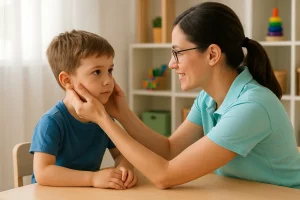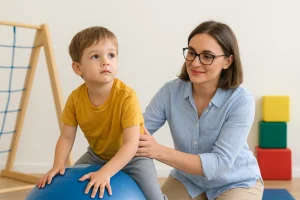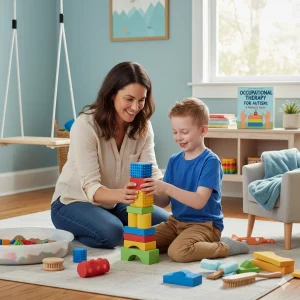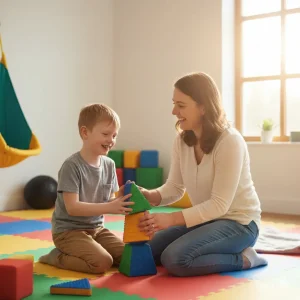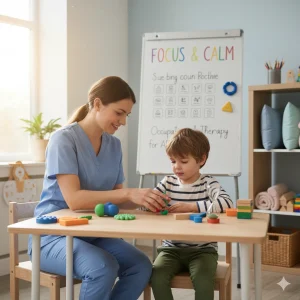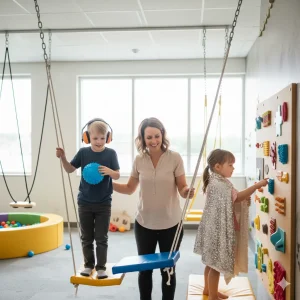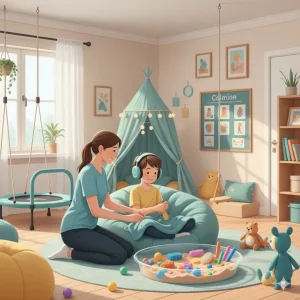Occupational Therapy for 2-Year-Olds: A Parent’s Guide
By Wellness Hub
Last Updated: October 10, 2025
Every toddler is busy learning how to move, explore, and connect with the world — and at age 2, those small movements mean big milestones. This is where occupational therapy for toddlers plays a powerful role.
For many children, age two is a critical developmental window—a time when they’re mastering focus, improving balance, and refining essential fine motor skills like grasping, stacking, and self-feeding. These early skills lay the foundation for independence, school readiness, and cognitive growth.
Through play-based routines, sensory activities, and hands-on learning strategies, pediatric OT activities help toddlers build the focus and coordination they need to thrive. Early intervention isn’t just about catching delays—it’s about empowering children to reach their full potential.
Understanding Toddler Development at Age 2
By the time your child turns two, their little body is working hard behind the scenes to master a long list of important skills. This stage isn’t just about learning new words or exploring their surroundings—it’s also a time of rapid physical, sensory, and emotional growth. Understanding what’s typical at this age can help you support your child in the best way possible.
Key Milestones at Age 2
At this stage, most toddlers are refining fine motor, gross motor, and sensory processing skills while also developing stronger attention and coordination. Here’s what that looks like in everyday life:
- Fine Motor Skills: Picking up small toys, using a spoon, stacking blocks, turning pages in a book. This involves skills like the pincer grasp—the ability to pinch objects between the thumb and forefinger.
- Gross Motor Skills: Running without falling as often, climbing on and off furniture, throwing and kicking a ball, and starting to balance on one foot. These movements help build core strength and coordination.
- Sensory Development: Your toddler is exploring the world through touch, movement, sound, and sight. Sensory experiences give them essential input to help their brain make sense of their environment.
- Attention and Focus: At age 2, many children can focus on a simple task for a short period. This growing ability lays the foundation for learning and play.
How Occupational Therapy Supports These Milestones
Occupational therapy for 2-year-olds is designed to support these developmental leaps in fun, playful, and practical ways. A pediatric OT might work on:
- Strengthening pincer grasp through play activities like picking up small beads or stickers.
- Encouraging bilateral coordination—using both hands together—through activities like holding paper while coloring.
- Building core strength and balance with movement games like scooter rides, animal walks, or stepping stones.
- Providing vestibular input (balance and movement sensations) and proprioceptive input (body awareness) through climbing, pushing, swinging, and other sensory-rich play.
When toddlers receive the right kind of movement and sensory opportunities, their brains learn how to process information more efficiently. This can lead to improvements not just in movement but also in communication, social skills, and emotional regulation.
Early Support Builds Long-Term Confidence
Every child develops at their own pace—but having a clear understanding of what’s typical at age 2 helps parents notice both strengths and areas where extra support might help. Occupational therapy for toddlers isn’t just for children with delays. It can be a powerful tool to build confidence, independence, and strong developmental foundations early on.
When Does a 2-Year-Old Need Occupational Therapy?
Every toddler grows and develops in their own unique way—but sometimes, parents may start to notice that their child is finding certain everyday tasks a little harder than expected. Maybe your child struggles to hold a spoon, has a hard time focusing during play, or seems unsteady when walking or climbing. These could be signs that your child may benefit from early intervention OT (occupational therapy).
Does my 2-year-old need occupational therapy?
This is one of the most common questions parents ask when they start to notice subtle differences in their child’s development. While some delays are perfectly normal and children often catch up at their own pace, certain red flags may be worth paying closer attention to.
Common Red Flags to Watch For
Here are a few signs that may suggest it’s time to see an occupational therapist:
- Fine motor delays: Difficulty picking up small objects, holding a crayon, using a spoon, or stacking blocks.
- Poor attention span: Struggling to stay focused on a short activity, flitting from one toy to another within seconds.
- Balance or coordination issues: Tripping frequently, falling often, or appearing unsure on uneven surfaces.
- Sensory sensitivities: Overreacting to loud sounds, avoiding messy textures like sand or paint, or seeking too much movement (spinning, crashing, climbing non-stop).
- Delayed independence: Challenges with simple daily tasks like feeding, dressing, or playing age-appropriate games.
These are not always signs of a major problem, but they can signal that your child may need a little extra support to build their skills.
Understanding Toddler Sensory Issues
Many toddlers who benefit from occupational therapy have what are known as toddler sensory issues. This means their brain may process sensory information—like touch, sound, movement, or pressure—a bit differently. For example, some children may avoid sensory input like sticky textures, while others may crave constant movement and pressure.
Occupational therapists help children get the right kind of sensory input through structured, playful activities that support better focus, coordination, and emotional regulation.
Why Early Intervention OT Matters
The earlier your child gets the right support, the easier it is to build strong developmental foundations. Early intervention OT doesn’t just help children “catch up.” It gives them the tools they need to gain confidence, develop independence, and feel more comfortable in their daily world.
If you’re unsure whether your child’s behavior is typical or needs attention, talking to an occupational therapist can give you clear answers and peace of mind. Trust your instincts—you know your child best.n
When Does a 2-Year-Old Need Occupational Therapy?
Every parent hopes their child will grow, learn, and explore the world with ease. But sometimes, you may notice your toddler is finding certain everyday activities more challenging than expected. This can raise questions like “Is this normal?” or “Should I get help?”
At age two, children are developing important skills like fine motor coordination, balance, attention, and sensory processing. A small delay isn’t always a cause for concern—but recognizing red flags early can make a meaningful difference in your child’s progress. That’s where early intervention OT (occupational therapy) comes in.
Does my 2-year-old need occupational therapy?
This is a common and very valid question many parents ask. The truth is, occupational therapy isn’t just for children with diagnosed conditions. It’s also for toddlers who may need a little extra support to build foundational skills for play, learning, and independence.
Understanding the signs early can help you decide when to see an occupational therapist for guidance and support.
Common Red Flags to Watch For
Every child develops at their own pace, but if you notice some of these signs, it may be helpful to get a professional opinion:
- Fine motor delays: Difficulty holding a spoon, picking up small objects, turning book pages, or stacking blocks.
- Poor attention span: Struggling to focus on one activity for even a short period, constantly hopping from one toy to another.
- Balance and coordination challenges: Frequent tripping, hesitating on stairs, or appearing wobbly when walking or climbing.
- Sensory sensitivities: Overreacting to loud noises, refusing messy textures like sand or playdough, or seeking intense movement like spinning or crashing.
- Delays in everyday independence: Trouble with simple tasks like feeding, dressing, or playing age-appropriate games.
These signs don’t always mean something is “wrong.” But they can signal that your child may benefit from occupational therapy for toddlers to strengthen their foundational skills.
Understanding Toddler Sensory Issues
Many toddlers who benefit from OT have what’s known as toddler sensory issues. This simply means their brain processes sensory information—like sound, movement, or touch—a little differently.
- A child who avoids sensory input might shy away from textures, loud environments, or physical contact.
- A child who craves sensory input may love spinning, crashing, climbing, or seeking pressure constantly.
Neither of these patterns is your fault as a parent—it’s simply how your child’s nervous system is wired. An experienced occupational therapist can help regulate these responses through structured, playful activities that build comfort, confidence, and coordination.
Why Early Intervention OT Matters
The earlier your child gets the right kind of support, the easier it is to build strong developmental skills. Early intervention OT isn’t just about “fixing delays.” It’s about giving your child the tools to thrive—to eat more independently, play more confidently, and explore their world with less frustration.
If you’ve ever wondered “When should I see an occupational therapist?” the best time is when you start to have those gut feelings as a parent. Trust your instincts. A gentle evaluation doesn’t commit you to therapy—it simply gives you answers and a clear plan to support your child’s growth.
Fine Motor Skill Activities for 2-Year-Olds (OT Focus)
If you’ve ever watched your toddler try to stack blocks or grip a crayon with those tiny fingers, you’ve seen fine motor skills in action. At age two, your child’s hands are learning to do big things — from feeding themselves to building towers and turning pages. These everyday actions may look simple, but they are actually the foundation for writing, dressing, eating, and even future classroom learning.
This is why focusing on fine motor skills for 2-year-olds is such a powerful way to support your child’s development at home. With a few playful activities, you can help strengthen their pincer grasp, improve hand-eye coordination, and build bilateral coordination (using both hands together) in a natural and fun way.
Why Fine Motor Skills Matter at Age 2
Fine motor skills are all about strength, control, and precision of the small muscles in the hands and fingers. Strong fine motor skills help your toddler:
- Hold utensils like a spoon or fork
- Pick up small snacks like Cheerios or beads
- Turn the pages of a book
- Begin scribbling and drawing simple lines
- Dress and undress with a little more independence
When these skills develop smoothly, children are better prepared for preschool activities like coloring, using scissors, and eventually, handwriting.
Simple OT Activities for Toddlers at Home
You don’t need fancy tools or expensive toys to build strong fine motor skills. Many OT activities for toddlers can be done with everyday materials you already have at home. Here are some tried-and-tested favorites:
- Playdough Squeezing and Rolling: Strengthens finger and hand muscles. Encourage your child to roll balls, flatten shapes, or pinch and pull.
- Pegboard Play or Stacking Cups: Helps refine hand-eye coordination, improves pincer grasp, and encourages problem-solving.
- Spoon and Cup Practice: Let your toddler practice scooping and transferring water, rice, or small snacks from one container to another. This builds control and bilateral coordination.
- Lacing Beads or Pasta: Strengthens finger control and focus. Start with larger items and work toward smaller beads as their skills improve.
These activities are designed to build skills through play, making learning natural and stress-free for your toddler.
Parent Tip: Keep It Playful, Not Perfect
The goal isn’t to make your child “perform” but to let them explore, repeat, and practice at their own pace. Give plenty of encouragement, model the actions, and keep the environment calm and engaging. Repetition is how little hands grow stronger and more confident.
Balance and Core Strength Activities for Toddlers
If you’ve ever watched your toddler wobble, jump, or try to balance on one foot, you’ve seen how hard their little bodies are working to build core strength and balance. These skills are more than just cute milestones—they’re the foundation for running, climbing, sitting upright, and even learning to focus.
At this age, your child’s body is rapidly developing postural control, learning how to stay steady, adjust movements, and build coordination. Supporting this growth through fun, everyday balance activities for toddlers can make a big difference in how confidently they move through the world.
Why Balance and Core Strength Matter at Age 2
Strong core muscles help your child:
- Stand upright with stability and less fatigue
- Improve walking, running, climbing, and jumping
- Develop better posture for sitting during play or meals
- Strengthen their gross motor skills, preparing them for preschool and beyond
Balance and core control are also closely linked to focus and attention. When children feel stable in their bodies, they’re better able to participate in play, follow instructions, and explore with confidence.
Fun Balance Activities for Toddlers
You don’t need fancy equipment to build core strength. Many core strength activities for 2 year olds can be set up at home with just a little creativity and space. Here are a few engaging ideas:
- Stepping Stones: Use foam pads, pillows, or homemade “stones” on the floor. Encourage your toddler to walk from one to another to build balance and coordination.
- Scooter Board Play: Let them sit or lie on their tummy while pushing themselves forward. This strengthens their core and shoulders.
- Animal Walks: Pretend to be different animals — a bear, crab, or frog. These movements encourage proprioceptive play and build strength in both the core and limbs.
- Balance Beam (or Tape Line): Create a simple beam using masking tape or a low plank. Walking across improves postural control and body awareness.
These simple, playful activities support gross motor development while giving your child plenty of movement freedom.
Parent Tip: Keep It Safe and Encouraging
When introducing new movement challenges, safety and confidence come first. Provide a soft surface, stay close to support if needed, and cheer them on with every small success. Remember, progress looks different for every child — it’s the practice and play that matter most.
Building Focus and Attention Through Play
Every parent knows how challenging it can be to get a 2-year-old to focus for more than a few seconds. Whether it’s sitting through a simple activity or following a short instruction, toddlers are still learning how to pay attention, regulate their behavior, and stay engaged.
The good news is, focus is a learned skill, and like any other skill, it can be nurtured through playful, structured experiences. With the right focus activities for toddlers, you can gently build their attention span in a way that feels fun, not forced.
Why Focus and Attention Matter at Age 2
At this stage, your child’s brain is rapidly developing the ability to:
- Listen and respond to short, simple instructions.
- Stay with an activity for a few minutes at a time.
- Take turns during play, learning patience and self-regulation.
- Build early skills needed for group play, language development, and later learning.
Strengthening attention isn’t just about getting your toddler to “sit still.” It’s about supporting behavioral regulation and co-regulation—which means learning to calm down, follow cues, and engage with the world more confidently.
Simple OT Strategies to Build Focus Naturally
Many OT strategies for attention don’t require special tools—they can easily fit into your child’s daily routine. Here are a few practical tips:
- Keep routines structured and predictable: Toddlers focus better when they know what to expect. Consistent daily patterns give them a sense of security.
- Use simple, clear commands: Short phrases like “Come here,” “Pick up,” or “Sit down” help your child process information more easily.
- Start small, build up: Begin with short activities (1–2 minutes) and gradually extend as your child’s attention grows.
- Create calm spaces: Minimize distractions like loud TV or clutter when working on activities that need more focus.
Fun Attention Span Activities for 2-Year-Olds
These attention span activities for 2-year-olds are simple but effective for building focus through movement and play:
- “Come Here” Game: Take turns calling your toddler from across the room. This builds listening skills, eye contact, and response time.
- Ball Roll and Stop: Sit opposite your child and roll a ball back and forth. Add simple instructions like “Stop,” “Wait,” or “Roll it to me.” This encourages listening, turn-taking, and focus.
- Mini Obstacle Course: Set up a soft play area with tunnels, cushions, or stepping stones. Following simple steps like “climb,” “jump,” and “crawl” helps build attention while supporting motor development.
These activities work because they blend movement, listening, and fun—the three ingredients toddlers respond to best.
Co-Regulation: A Parent’s Secret Superpower
At this age, your child doesn’t just learn focus alone—they learn it through you. Co-regulation means guiding your toddler’s emotional and behavioral responses by modeling calmness, using gentle voice cues, and offering reassurance.
For example, if your child gets distracted or frustrated, staying calm and helping them return to the activity teaches them how to manage their attention over time. This is an essential foundation for future self-regulation.
Sensory Play Ideas for 2-Year-Olds (OT Approved)
If you’ve ever watched your child squish playdough, splash in water, or dig their hands into a pile of sand, you’ve witnessed sensory play in action. For toddlers, these simple, joyful activities are not just fun—they’re a powerful way to build brain and body connections.
At age two, children learn best by touching, moving, and exploring their surroundings. This is why sensory activities for 2-year-olds are a key part of occupational therapy. They help develop tactile input (touch), proprioceptive input (body awareness), and vestibular system (balance and movement), all of which are essential for healthy growth and learning.
Why Sensory Play Matters for Toddlers
Sensory play gives your child’s developing brain the input it needs to organize and respond to the world. It supports:
- Calm and focus: Sensory play can help regulate emotions and reduce overstimulation.
- Motor development: Activities that involve touching, squeezing, pouring, and moving strengthen both fine and gross motor skills.
- Body awareness: Engaging the senses helps toddlers understand where their body is in space, improving balance and coordination.
- Early learning skills: Sensory play encourages curiosity, problem-solving, and language development.
For many children, sensory experiences also build the foundation for sensory integration—the brain’s ability to process and respond to sensory input effectively.
Easy Toddler Sensory Play Ideas
You don’t need expensive toys or special equipment to create meaningful toddler sensory play ideas. A few everyday materials can make playtime both fun and therapeutic.
- Water Play: Fill a small tub or basin with water. Add cups, spoons, or small toys for scooping and pouring. This encourages tactile exploration and helps develop hand-eye coordination.
- Sand Bins or Rice Tubs: Let your child dig, scoop, and pour using their hands or tools. This builds tactile awareness and fine motor strength.
- Finger Painting: A classic OT-approved activity that strengthens sensory processing, creativity, and motor skills. Let them feel the paint’s texture and experiment with different strokes.
- Sensory Bags: Fill a ziplock bag with gel, beads, or other safe materials. Seal it tightly and let your toddler press, squish, and explore without the mess.
These activities encourage both independent exploration and guided play, allowing you to support your child’s sensory development in everyday moments.
How Sensory Play Supports Regulation
For many toddlers, sensory play isn’t just enjoyable—it’s calming. Activities that engage the vestibular system (like gentle swinging or spinning), or provide proprioceptive input (like pushing and pulling) can help children regulate their energy levels and emotions. This is especially helpful during transitions or meltdowns.
A few extra ideas:
- Swinging gently in a hammock or baby swing.
- Rolling on a soft mat.
- Pushing a toy cart or weighted laundry basket.
These simple activities can help your child feel more grounded, focused, and secure in their body.
Parent Tip: Follow Your Child’s Lead
Sensory play is most effective when it’s child-led. Observe how your toddler reacts to different textures and movements. Some may love water play, while others prefer sand or squishy bags. Respect their comfort levels and gently introduce new sensations at their pace.
Best Tools and Toys for OT at Home
One of the best things about occupational therapy for toddlers is that it doesn’t only happen in a clinic. With the right OT-friendly toys, your home can become a powerful space for growth, learning, and play.
At age two, children learn best when they can touch, move, build, and explore. That’s why investing in a few home OT tools can make everyday play both fun and purposeful. The goal isn’t to overload your home with gadgets—it’s to choose a few versatile, open-ended toys that build fine motor skills, strengthen coordination, and support sensory development naturally.
Why OT Toys Matter
The right toys help your child develop:
- Fine motor strength and coordination: essential for feeding, dressing, and pre-writing skills.
- Bilateral coordination: using both hands together, which is key for tasks like holding paper while coloring.
- Balance and postural control: supporting confident movement and gross motor skills.
- Sensory integration: providing tactile, proprioceptive, and vestibular input through hands-on play.
Using occupational therapy toys for toddlers isn’t about structured “therapy sessions.” It’s about weaving skill-building moments into your child’s natural play.
Best Toys for Fine Motor Skills for 2-Year-Olds
Here are a few tried-and-true favorites that parents and pediatric OTs often recommend:
- Stacking Blocks or Cups: Great for hand-eye coordination, grip strength, and problem-solving. Toddlers learn to balance, build, and knock down—building both confidence and control.
- Playdough Sets: Perfect for squeezing, rolling, and shaping. Playdough strengthens little hand muscles and encourages creativity while improving fine motor precision.
- Lacing Boards or Beads: Help toddlers practice bilateral coordination and pincer grasp. Start with chunky beads and progress to smaller ones as skills develop.
- Ride-On Toys: These build core strength, balance, and coordination while giving your child a sense of movement and independence.
- Shape Sorters: Support problem-solving, spatial awareness, and hand control in a fun and interactive way.
Pro tip: Choose toys that your child can use in multiple ways. Open-ended toys grow with your child and can be used for years.
Recommended Home OT Tools (Parent Favorites)
For parents looking to bring therapy-inspired play into the home, here are a few practical and effective OT tools:
- Scooter board – encourages balance, core strength, and proprioceptive play.
- Sensory bins – simple tubs filled with sand, rice, or water for tactile exploration.
- Therapy putty or dough – for strengthening fine motor skills in a playful way.
- Mini trampolines – for safe indoor movement and vestibular input.
- Weighted lap pads or toys – calming tools for sensory regulation.
Parent Tip: It’s Not About More, It’s About Meaningful
You don’t need to buy every toy on the shelf to support your child’s development. A small selection of well-chosen, purposeful toys—combined with your presence and engagement—is often more effective than dozens of flashy gadgets. The real magic happens when your child explores, experiments, and plays at their own pace.
How to Integrate OT Activities Into Daily Routines
Supporting your toddler’s development doesn’t always require a structured therapy session or expensive equipment. In fact, some of the most effective OT activities can happen during the everyday moments you already share with your child—like mealtime, bath time, or getting dressed.
Turning these regular routines into home OT exercises for 2-year-olds is a gentle and powerful way to build fine motor skills, self-care skills, and early independence. This approach also helps children feel more confident and capable in their daily world.
Why Daily Routines Are Perfect for OT
Daily routines offer repetition, consistency, and real-life context, which are ideal conditions for learning new skills. Instead of creating separate “therapy time,” you can weave everyday OT activities for toddlers into natural moments throughout the day.
Benefits of embedding OT into daily routines include:
- Strengthening hand and body coordination.
- Building independence in Activities of Daily Living (ADLs) like eating, dressing, and bathing.
- Encouraging problem-solving and sequencing skills.
- Reducing frustration during transitions through predictable patterns.
- Supporting emotional regulation by giving your child structure and a sense of control.
Mealtime: A Natural OT Opportunity
Mealtime is about more than just eating—it’s a fantastic way to build fine motor and sensory skills.
- Scooping with a spoon helps strengthen grip and hand-eye coordination.
- Drinking from an open cup encourages bilateral coordination and oral motor development.
- Finger feeding supports tactile exploration and pincer grasp.
- Involving your child in setting the table (placing napkins, cups, spoons) builds planning and sequencing skills.
Parent Tip: Allow a little extra time and let your child try—even if it gets messy. These moments are essential for skill-building.
Bath Time: A Sensory Playground
Bath time can be a calming and engaging sensory experience that builds body awareness and independence.
- Squeezing sponges or bath toys strengthens hand muscles.
- Pouring water between cups develops fine motor control and bilateral coordination.
- The warm water provides gentle proprioceptive input, helping your child relax and focus.
- Encouraging your toddler to wash parts of their own body builds self-care and independence.
Parent Tip: Use simple verbal prompts like “wash hands” or “pour the water here” to build both language and motor planning.
Dressing: Practicing Self-Care Skills
Getting dressed may seem simple to adults, but for toddlers, it’s a complex sequence of fine motor, gross motor, and problem-solving steps.
- Pulling up pants and putting on shoes help develop body coordination and core strength.
- Zipping and unzipping, or practicing buttons with help, builds finger dexterity and bilateral coordination.
- Naming each clothing item as they wear it can support communication and sequencing.
Parent Tip: Encourage independence by giving your child easy-to-handle clothing, like elastic waistbands or Velcro shoes, to set them up for success.
Consistency Is the Key
The beauty of daily routines is that they happen naturally and consistently—which is exactly how children learn best. Over time, these repeated opportunities help build stronger motor skills, better attention, and growing independence.
Conclusion
Early support can make a big difference in your child’s growth. If your toddler struggles with balance, fine motor skills, or daily routines, pediatric occupational therapy can help build these skills through fun, play-based activities. An OT evaluation for 2-year-olds is gentle, child-friendly, and focused on helping your child thrive at their own pace. Early intervention therapy strengthens confidence, coordination, and independence in everyday life. Trust your instincts as a parent — seeking help early can set your child up for long-term success.
Frequently Asked Questions:
1. What is occupational therapy for 2-year-olds?
Occupational therapy helps toddlers build the everyday skills they need to grow and learn. Through fun, play-based activities like stacking blocks, sensory play, and balance exercises, it supports their fine motor skills, focus, and independence. It’s not about medical treatment — it’s about helping your child thrive in daily life.
2. How do I know if my 2-year-old needs occupational therapy?
Every child develops at their own pace, but some signs can show when extra support may help. If your toddler struggles with holding objects, focusing on tasks, or gets easily overwhelmed by textures or sounds, an OT evaluation for 2-year-olds can identify what kind of help they need early.
3. What are common signs my toddler may need occupational therapy?
Some red flags include difficulty using utensils, poor balance, short attention span, sensory sensitivities (like covering ears or avoiding touch), and delays in daily self-care skills. These signs don’t mean something is wrong — they simply suggest that your child may benefit from extra support.
4. What happens during a pediatric OT session?
A pediatric occupational therapy session often looks like play. Therapists use structured games and movement activities—such as obstacle courses, playdough work, or scooter boards—to help toddlers strengthen coordination, focus, and sensory processing. Sessions are fun and engaging, so children enjoy the process.
5. Is occupational therapy only for children with special needs?
No, OT isn’t just for children with a diagnosis. Many toddlers who have mild delays or need help catching up with skills can benefit from early intervention therapy. The goal is to build strong foundations early so they feel more confident and independent as they grow.
6. What kind of activities do occupational therapists use with toddlers?
OT sessions use a variety of hands-on activities like water play, finger painting, balance games, stacking blocks, sensory bins, and lacing beads. These are carefully chosen to improve your child’s motor skills, attention, coordination, and sensory integration in a playful, non-stressful way.
7. Can I do OT activities at home with my child?
Yes, absolutely! You can easily turn everyday play into home OT exercises for 2-year-olds. Activities like pouring water, squeezing playdough, or walking on pillows can help build your toddler’s strength, coordination, and focus. Parents play a big role in supporting progress between therapy sessions.
8. How long does occupational therapy take to work?
Progress depends on your child’s individual needs. Some children make noticeable improvements in a few weeks, while others may benefit from ongoing therapy over several months. Consistency, early intervention, and practicing at home can speed up results.
9. Will my toddler enjoy occupational therapy?
Most toddlers love OT because it feels like playtime, not therapy. Sessions are filled with movement, creativity, and games designed to match your child’s interests. When therapy feels fun, children are more motivated and make faster progress.
10. Do I need a doctor’s referral for occupational therapy?
In many cases, you can contact a pediatric occupational therapist directly for an evaluation. However, some insurance plans or programs may ask for a referral. If you’re unsure, your pediatrician can guide you on the best next steps.
About Author:
Sonali Sharma, Occupational Therapist
Sonali Sharma is a skilled Occupational Therapist at Wellness Hub, with over three years of experience in supporting children with developmental, behavioral, and learning challenges. She holds a Bachelor’s in Occupational Therapy (BOT) from Amity University and has worked with leading institutions such as NIMHANS Bengaluru and ESIC Hospital Faridabad.
At Wellness Hub, Sonali provides online occupational therapy sessions tailored to each child’s needs. She specializes in pediatric therapy, autism support, sensory integration, and developmental skill-building, helping children strengthen motor skills, improve focus, and become more independent in daily life.
Her therapy style is child-centered, play-based, and evidence-driven—making sessions both effective and enjoyable for kids. Sonali also equips parents with practical home therapy strategies to extend progress beyond sessions.
Passionate about empowering families, Sonali believes in creating a nurturing space where children can thrive while parents feel supported every step of the way.
Book your Free Consultation Today
Parent/Caregiver Info:
Client’s Details:
* Error Message
